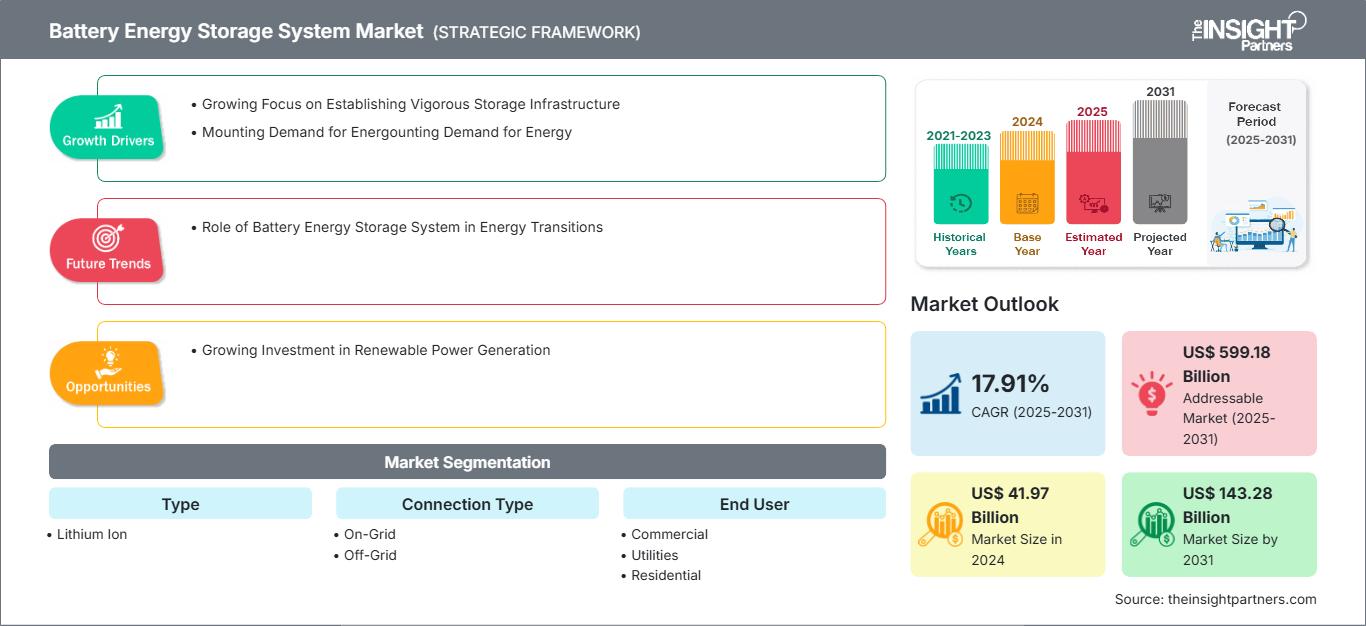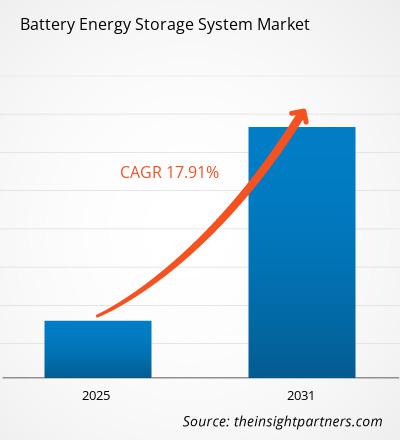预计到2031年,电池储能系统市场规模将从2024年的419.7亿美元增至1432.8亿美元。预计2025年至2031年期间,该市场的复合年增长率将达到17.91%。电池储能系统在能源转型中的作用可能会在未来几年引发市场新的关键趋势。
电池储能系统市场分析
可再生能源行业的快速增长、电池储能系统需求的激增以及政府对公用事业可再生能源项目资金的增加,是推动电池储能系统市场发展的关键因素。此外,预计全球对可再生能源发电的投资不断增长,将在预测期内为在该市场运营的主要公司创造丰厚的利润。此外,预计电池储能系统在能源转型中的作用将成为2025年至2031年市场未来发展的关键趋势。
能源生产商、输电系统运营商、储能供应商和最终用户都是电池储能系统生态系统的利益相关者。用于发电的能源包括天然气、化石燃料和可再生资源(例如风能和太阳能)。发电之后是输电和储能过程。储能过程涉及大型设施和分布式电源或储能系统。最后一步是将存储的电能分配给最终用户或主要应用领域。电池储能系统的最终用户包括发电厂、商业、住宅和公用事业部门。
电池储能系统市场概览
电池储能系统 (BESS) 增强了电网的弹性和可靠性。此外,该系统通过套利降低电力成本,并通过提供备用电源来降低限电风险。这些优势吸引了北美、欧洲和亚太地区(尤其是美国、德国、英国、意大利、中国、印度、日本和韩国)的开发商和政府,使其更加关注电池储能基础设施。例如,各州政府正在加大力度鼓励储能与太阳能的整合。在美国,《通胀削减法案》(IRA)为安装太阳能+储能系统和独立电池储能系统提供税收抵免,这有利于该国的电池储能系统市场。
印度政府于2021年5月推出了与先进化学电池生产挂钩的激励计划,旨在减少对进口电池的依赖,促进该国的工业发展。该计划旨在通过财政激励措施提高印度在储能领域的制造能力。印度政府批准了可行性缺口融资 (VGF) 计划,用于在 2023 年建立 4,000 MWh 的电池储能系统。该计划为 VGF 提供的资金最高可达 BESS 资本支出的约 40%,这将降低从 BESS 获取电力的成本。
自定义此报告以满足您的要求
您将免费获得任何报告的定制,包括本报告的部分内容,或国家级分析、Excel 数据包,以及为初创企业和大学提供超值优惠和折扣
电池储能系统市场: 战略洞察

- 获取本报告的主要市场趋势。这个免费样本将包括数据分析,从市场趋势到估计和预测。
您将免费获得任何报告的定制,包括本报告的部分内容,或国家级分析、Excel 数据包,以及为初创企业和大学提供超值优惠和折扣
电池储能系统市场: 战略洞察

- 获取本报告的主要市场趋势。这个免费样本将包括数据分析,从市场趋势到估计和预测。
电池储能系统市场驱动因素和机遇
不断增长的能源需求有利于电池储能系统市场
人口增长和城市化进程加快是影响全球能源使用的两个因素,尤其是在美国、中国、印度和日本等国家。根据美国能源信息署 (EIA) 的数据,由于经济和人口增长,预计到 2050 年美国的能源消耗将增加。EIA 还报告称,2022 年美国电力终端消费量比 2021 年高出约 3.2%。它进一步预测,2025 年电力消耗将增长 0.7%。电池储能具有在危机时期或没有电网的偏远地区应用的潜力。此外,由于全球能源不确定性增加,美国政府正在鼓励应用电池储能系统。例如,2024 年 5 月,Plus Power 从摩根士丹利银行获得了 8200 万美元的税收股权投资,用于位于亚利桑那州的 90 兆瓦/360 兆瓦时的 Superstition BESS 项目,预计该项目将于 2024 年 6 月投入运营。2024 年 2 月,RWE 在德克萨斯州和亚利桑那州完成了三个新电池储能系统的建设,总容量为 190 兆瓦(361 兆瓦时)。
加拿大不断增长的能源需求也推动了电池储能市场的增长。例如,SolarBank Corporation 计划于 2025 年 2 月下半月在安大略省开始建设其首个电池储能系统项目。加拿大皇家银行将为这个 4.99 兆瓦的 BESS 项目提供 2580 万美元的融资。
加大对可再生能源发电的投资以创造增长机会
美国政府正致力于减少碳足迹,推动全国向清洁能源转型。因此,政府正在鼓励对绿色能源生产进行投资。使用化石燃料发电是导致气候变化的温室气体 (GHG) 排放的主要因素。由于人们越来越重视使用清洁和绿色能源、日益增长的气候变化问题以及政府鼓励在美国使用可再生能源的举措,太阳能和风能的利用率正在增加。美国政府的目标是到 2030 年将温室气体净排放量在 2005 年的基础上减少约 50% 至 52%,到 2050 年实现净零排放。因此,对温室气体排放日益增长的担忧促使人们投资可再生能源发电,预计这将为预测期内电池储能系统市场的发展提供丰厚的机会。
亚太地区各国政府都已将增加可再生能源发电装置作为目标。 2023 年,印度政府发布了一份招标通知,在未来 5 年内每年招标 50 吉瓦的可再生能源容量,到 2030 年底达到 300 吉瓦的目标。同样,日本政府的目标是将其海上风电容量从 2022 年的 0.14 吉瓦增加到 2030 年底的 10 吉瓦。此外,中国在 2023 年完成这些系统的安装,提前 6 年实现了 2030 年的可再生能源目标。因此,在预测期内,对可再生能源发电的投资不断增加将为电池储能系统市场带来增长机会。
电池储能系统市场报告细分分析
有助于得出电池储能系统市场分析的关键细分是类型、连接类型和最终用户。
- 就类型而言,市场分为锂离子和其他。 2024 年,锂离子电池占据了更大的市场份额。
- 根据连接类型,电池储能系统市场分为并网和离网。2024 年,并网市场占据了主导地位。
- 按最终用户划分,电池储能系统市场分为商业、公用事业和住宅。2024 年,公用事业市场占据了最大的市场份额。
按地区划分的电池储能系统市场份额分析
电池储能系统市场报告的地理范围提供了详细的全球、区域和国家分析。北美、欧洲和亚太地区是市场增长的主要贡献地区。2024 年,北美占据了电池储能系统市场的主导地位,份额为 47.8%;在预测期内,北美很可能继续占据主导地位。欧洲是电池储能系统市场的第二大贡献者,其次是亚太地区。美国和中国是电池储能系统市场显著增长的主要国家,这得益于政府加大对可再生能源发电的投入和举措,以及微电网和电池储能系统容量的扩大。可再生能源使用意识的增强以及对太阳能和风能项目的投资不断增加,推动了美国对储能用锂离子电池的需求。2023 年,美国可再生能源装机量较 2021 年增长约 37%,较 2022 年增长 51%。
预计部分地区停电或电网接入受限期间对备用电源的需求将增加,这将凸显美国对电池储能系统 (BESS) 的需求。此外,美国各地的微电网和离网系统中电池储能系统的使用量有所增加,以确保稳定可靠的电力供应。此外,预计未来几年,全国范围内对太阳能和风能项目的投资和发展举措将推动电池储能系统市场的增长。 2023 年,德克萨斯州在该地区安装了约 6,500 兆瓦的太阳能系统,超过加利福尼亚州,成为美国可再生能源装机容量最大的州。
电池储能系统市场报告覆盖范围和可交付成果
《电池储能系统市场规模和预测(2021-2031 年)》报告对市场进行了详细的分析,涵盖以下领域:
- 涵盖范围内所有主要市场领域的电池储能系统市场规模和国家/地区预测
- 电池储能系统市场趋势以及市场动态,例如驱动因素、限制因素和关键机遇
- 详细的 PEST 和 SWOT 分析
- 电池储能系统市场分析,涵盖主要市场趋势、国家/地区框架、主要参与者、法规和最新市场发展
- 行业格局和竞争分析,涵盖市场集中度、热图分析、知名参与者和电池储能系统的最新发展市场
- 详细的公司简介
电池储能系统市场区域洞察
The Insight Partners 的分析师已详尽阐述了预测期内影响电池储能系统市场的区域趋势和因素。本节还讨论了北美、欧洲、亚太地区、中东和非洲以及南美和中美洲的电池储能系统市场细分和地域分布。
电池储能系统市场报告范围
| 报告属性 | 细节 |
|---|---|
| 市场规模 2024 | US$ 41.97 Billion |
| 市场规模 2031 | US$ 143.28 Billion |
| 全球复合年增长率 (2025 - 2031) | 17.91% |
| 历史数据 | 2021-2023 |
| 预测期 | 2025-2031 |
| 涵盖的领域 |
By 类型
|
| 覆盖地区和国家 | 北美
|
| 市场领导者和主要公司简介 |
|
电池储能系统市场参与者密度:了解其对业务动态的影响
电池储能系统市场正在快速增长,这得益于终端用户需求的不断增长,而这些需求的驱动因素包括消费者偏好的转变、技术进步以及对产品优势的认知度的提升。随着需求的增长,企业正在扩展产品线,不断创新以满足消费者需求,并抓住新兴趋势,从而进一步推动市场增长。

- 获取 电池储能系统市场 主要参与者概述
- 历史分析(2 年)、基准年、预测(7 年)及复合年增长率
- PEST和SWOT分析
- 市场规模、价值/数量 - 全球、区域、国家
- 行业和竞争格局
- Excel 数据集
近期报告
相关报告
客户评价
购买理由
- 明智的决策
- 了解市场动态
- 竞争分析
- 客户洞察
- 市场预测
- 风险规避
- 战略规划
- 投资论证
- 识别新兴市场
- 优化营销策略
- 提升运营效率
- 顺应监管趋势




















 获取免费样品 - 电池储能系统市场
获取免费样品 - 电池储能系统市场